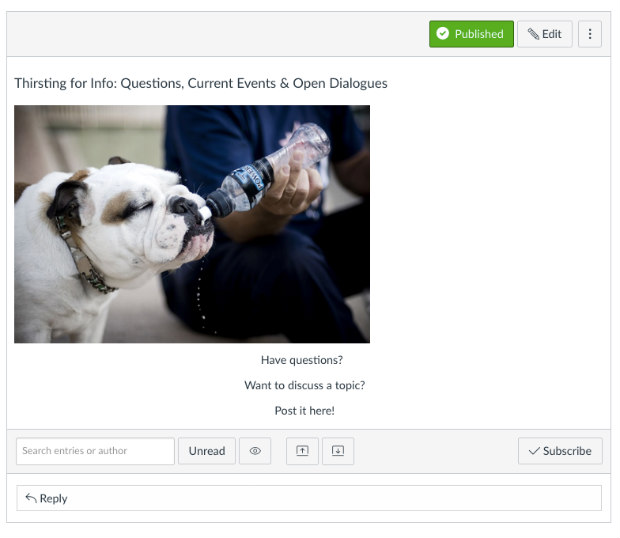When teachers are tasked with developing an online course, their thinking often follows along these lines: This is what I do in class. How can that be translated online?
What if we reversed our thinking?
Instead of assuming what’s done on ground is ideal, what if we looked at teaching online as a means of improving our face-to-face teaching skills? The process of developing an online course, starting with a clean slate instead of converting resident instruction via technology, leads to an examination of our classroom-based course design, assumptions about learning, and ultimately improves instructional practice in both settings along several dimensions: teaching persona, power distance, instructional clarity, student interaction, and learning assessment.
Presence and Distance
From the minute we enter the classroom, students are sizing us up. Our appearance, demeanor, voice, word choice, and mannerisms project an image. Similarly, the teacher may notice a variety of student characteristics: clothing, tone of voice, behavior, and level of attention. All this happens automatically when we share a physical space with our students.
Online first impressions begin with the learning management interface, course organization, and whatever materials and resources the teacher has chosen to share when the course opens. While teaching online means we may not have to worry about physical appearance, it does mean we have to spend time thinking about how to create and maintain a presence online. Who am I? How can or should I communicate my identity to students?
I didn’t invest a lot of time thinking about this before I started teaching online. Thus, I missed opportunities to make learning personal. Online teaching forces us to think more carefully about persona, values, and priorities than the face-to-face context. It has made me more intentional about establishing and maintaining my teaching persona online and face-to-face. For example, the welcome module in the online section begins with a segment called Navigating the Course. I hadn’t thought about creating a resource like this for resident students. But after I developed a page of short descriptions and examples for the online environment, it was clear that all of my students would find this information helpful. Below is an example from my resident course in accounting.
The lack of social cues is a common reason faculty give for resisting online teaching. But let’s be honest. How many of your students do you really get to know? It’s easy to assume physical presence automatically leads to relationship building, among students and between the teacher and students. Before I started teaching online, most of the connections I made with students happened during office hours.
While I strive to learn everyone’s name and circulate around the room regularly each period, I can’t say I’ve really gotten to know each student, particularly in large sections. Yet facilitating relationships across the geographically dispersed and asynchronous online classroom requires a more intentional approach. As I developed online strategies for students to get to know each other and me, I realized how haphazardly I fostered a sense of community in resident instruction.
I’ve adapted the online “getting to know you” tactics for my face-to-face courses. I’ve also provided an online space for frequently asked questions (FAQ Forum) in resident classes. Sometimes referred to as The Water Cooler, the forum is a place for students to answer each other’s questions or connect about non-course related topics. Before I taught online, I hadn’t thought about setting up a virtual space for students to interact informally. After all, they see each other in class. But student feedback suggests students, resident and online, appreciate being able to connect outside of formal course discussions. Below is a screenshot from a resident section of an honors microeconomics course.
Use of the forum varies each term, depending on the composition of students and how diligently I promote its use. Overall, the availability of a virtual student space increases the sense of community in the course.
Clarity and Unproductive Cognitive Load
The importance of structure, sequence, and clarity cannot be overstated in the online environment. Cognitive load should be focused on learning content, not trying to figure out what the teacher wants, searching for resources, or solving learning management system mysteries. Of course, teachers want instructions to be clear for resident students too, but the opportunity for face-to-face questioning before, during, and after class means the stakes aren’t nearly as high as they are online.
Thus, a critical aspect of developing an online course is predicting and avoiding points of confusion. This applies to how the materials are organized, instructions for assessments, and clarity in content delivery—often across a range of media. Online students’ frustration stemming from unproductive cognitive load leads to late drops, missed or incomplete assignments, and poor course evaluations. When instructions, layout, and sequencing work well online, it is virtually assured they will be clearly understood by resident students too. Thus, materials and planning for online instruction saves time and stress for teachers and students, in both settings.
Student Interaction
Many teachers want to promote and encourage discussion and interaction, for a variety of learning and instructional reasons. In technical disciplines, promoting discussion can be particularly challenging. Many teachers in technical fields, and I count myself in this group, face additional hurdles by the nature of the content. Neither accounting nor economics is known for discussion pedagogy in resident instruction. Indeed, a survey of 275 economics faculty report “leading class discussions” represents only 20 percent of instructional time (Goffe & Kauper, 2014). Based on my research, I suspect the percentage is even lower in accounting.
Yet online economics and accounting courses routinely integrate interaction through online discussions in formative and summative assessments. Effective online interactions focus on interesting (from the students’ perspectives) topics, real-world issues that allow for open-ended prompts, and activities with multiple outcomes and explanations. They can serve as a hook for content or a means of evaluating students’ understanding.
After seeing the depth of application and understanding my online accounting students achieved through online case study discussions, I integrated online discussion in my face-to-face sections. The online format allows more introverted students to share their insights in a setting that works to their advantage. Online discussion provides a record of the exchange that students can revisit when they prepare for exams. The opportunity to discuss current events, apply concepts, and wrestle with ethical issues outside of class time means students engage with the content more frequently and in a deeper way than time allows in the classroom. And student feedback by online and resident students has been very positive.
An unexpected benefit of preparing for online discussion: my classroom discussion facilitation skills improved. I’ve learned to wait and let discussions unfold instead of jumping in at the first pause. I’ve also become more adept at letting new avenues, particularly ones I hadn’t anticipated, be explored.
Rethinking Assessments
Starting online course design as a blank slate means formative and summative assessment options are wide open. Exams and papers are a common default selection for resident instruction, not necessarily optimal whether online or on ground.
Identifying and developing assessments for the online environment frequently leads to different types of learning activities, particularly ones leveraging more collaboration and creativity than in on ground versions of the course. Typical examples of deliverables online include demonstrations of learning by creating websites, curating online content, and making videos. Here are a few examples of free resources by project type:
- Presentations: Prezi, PechaKucha
- Video: YouTube, Animaker
- Curated Content/Infographic: Pinterest, Piktochart, Canva, Venngage
- Interactive Resources: ThingLink, Kahoot
- Websites: Wix, Weebly
Based on the success of these activities online in accounting, I expanded the assessment options in my resident economics courses. This increased student engagement, particularly at the end of the term when energy and focus wane. Instead of another final exam, my students now engage in projects utilizing a range of media and formats. What’s particularly striking here is that the process of reconsidering course design, delivery, and learning online leads to teaching and learning insights across disciplines and instructional settings. I expected to improve as an online teacher with time and experience. I didn’t expect it to enhance my teaching in the face-to-face classroom.
A recent Google search for “faculty resistance to teaching online” produced 12.4 million hits. Most articles discuss the barriers and risks, or incentives to get more faculty teaching online. My experience suggests framing the issue as a professional development opportunity may lead more teachers to consider developing online materials and eventually teaching online. For those not ready to plunge into full-blown course development, choosing one segment and developing it for the online setting is an excellent exercise in instructional improvement. Question your assumptions about how students best learn your content, explore alternative forms of assessment, talk with colleagues who’ve had success teaching online or blended courses.
Most of us teach because we care about students and want them to learn. I didn’t start teaching online to enhance my classroom instruction. But’s that’s exactly what happened. Preparing to teach online made me a better, more empathetic teacher, face-to-face and online. It may do the same for you.
References and Recommended Reading
Goffe, W. L., & Kauper, D. (2014). A survey of principles instructors: Why lecture prevails. 375
Al-Shalchi, O.N. (2009). The Effectiveness and Development of Online Discussions. Journal of Online Learning and Teaching, 5(1), 104–108.
Anderson, B., & Simpson, M. (2004). Group and class contexts for learning and support online: Learning and affective support online in small group and class contexts. The International Review of Research in Open and Distance Learning, 5(3). Retrieved from http://www.irrodl.org/index.php/irrodl/article/view/208/291
Orlando, J. (2014, March 3). Top 10 rules for developing your first online course. Faculty Focus. Retrieved from https://www.facultyfocus.com/articles/online-education/online-course-design-and-preparation/top-10-rules-developing-first-online-course
Bart, M. (2009, July 6). How to use the first day of class to set the tone for entire semester. Faculty Focus. Retrieved from
https://www.facultyfocus.com/articles/effective-classroom-management/how-to-use-the-first-day-of-class-to-set-the-tone-for-entire-semester
Ragan, L. (2009). 10 principles of effective online teaching: Best practices in distance education. Faculty Focus. Retrieved from https://www.facultyfocus.com/wp-content/uploads/2015/02/10-Principles-of-Effective-Online-Teaching.pdf
Carnegie Mellon Eberly Center for Teaching Excellence & Educational Innovation. Design & teach a course: make the most of the first day of class. Retrieved from http://www.cmu.edu/teaching/designteach/teach/firstday.html#2
Goffe, W. L. & Kauper, D. (2014). A survey of principles instructors: Why Lecture Prevails. The Journal of Economic Education, 45(4), 360–375.
Mesa Community College Center for Teaching and Learning. Designing an online course. Retrieved from http://ctl.mesacc.edu/teaching/designing-an-online-course/
Lolita Paff is an associate professor of business economics at Penn State Berks.








